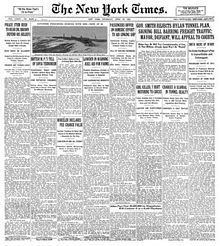Name SS Raifuku Maru Yard number 427 In service 1918 | Completed 1918 | |
 | ||
Owner Kawasaki Kisen Kaisha, Ltd. | ||
The SS Raifuku Maru (来福丸 (Kyūjitai: 來福丸), Raifuku Maru) was a Japanese Dai-ichi Taifuku Maru-class cargo ship, which was built in 1918 at Kawasaki Dockyard in Kobe, Japan, and owned by Kawasaki Kisen Kaisha, Ltd.. In April 1925, it sank in a heavy storm during a voyage from Boston, USA, to Hamburg, Germany, with a cargo of wheat and a crew of thirty-eight, all of whom were lost.
Contents
The sinking
The Raifuku Maru had sailed out of Boston on 18 April 1925. On 21 April, it sailed into a heavy storm, and the cargo of wheat began to shift, causing the ship to take on an increasing list to one side. The RMS Homeric, a liner of the White Star Line, and several other vessels received the following communication from the Japanese ship's wireless operator, Masao Hiwatari: "Now very danger! Come quick!" Despite the broken English of the Japanese crewmen, it was obvious that the vessel was in trouble. The Homeric (along with the British vessel King Alexander) tried desperately to reach the Raifuku Maru, but was unable to get close enough to rescue any crew due to the rough seas. The vessel was listing at a 30-degree angle, and sank with all hands while the Homeric's crew and passengers watched. The Homeric sent the following message to the Camperdown Signal Station: "OBSERVED STEAMER RAIFUKU MARU SINK IN LAT 4143N LONG 6139W REGRET UNABLE TO SAVE ANY LIVES." Several vessels attempted to locate bodies or survivors from the ship in the days after the sinking, but found none.
The incident was quite controversial at the time; when the Homeric arrived in New York, several of the passengers publicly accused the crew of the Homeric of not making enough effort to save the Raifuku Maru's crewmen. This was taken up by the Japanese government, who accused the English captains of racism for not saving their crewmen. However this was strenuously denied by the crew of the Homeric and the White Star Line who argued that they had made every effort to rescue the crew.
Myths and legends
According to a legend which grew up around the incident, the RMS Homeric received a cryptic SOS from the Raifuku Maru on April 21, 1925, which read, in broken English: "Danger like a dagger now! Come quick!" Reportedly, the Homeric traveled to where the vessel had given the SOS, but found not a trace of the ship. Mystery writers speculated over what the "dagger" was (with waterspouts and UFOs frequently blamed), and this was regarded as a genuine mystery of the sea by many. Popular writers on the Bermuda Triangle, specifically Charles Berlitz and Vincent Gaddis, propagated the myth of the vessel's "mysterious" sinking.
